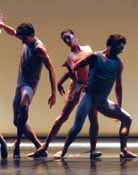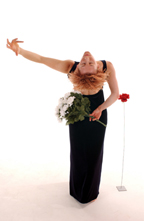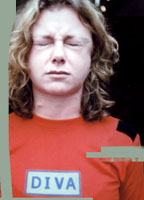The American Forsythe
Ballett
Frankfurt
Brooklyn Academy of Music
September 30-October 5, 2003
By
Nancy Dalva
Copyright
©2003 by Nancy Dalva
 Native
son William Forsythe returned to New York City this week, to warm acclaim.
The four performances at the Brooklyn Academy of Music were the last here
for the Frankfurt Ballet, which will disband next summer after a final
American tour. Having fallen out with the city burghers, the maverick
Forsythe, who has for some twenty years directed his troupe under Frankfurt's
sponsorship, will then move on. (Though perhaps not far. At press time,
he had any number of balls in the air, including regrouping under a new
banner in Frankfurt itself.) Like that other prodigal, Mark Morris, who
made rude remarks about Belgian royalty and Bejart and was booted out
of Brussels, Forsythe has only gained in American affection from his recent
political difficulties abroad. With interesting synchronicity, the program
he brought here, four works new to New York, was distinctively American
looking, while usually what one sees of Forsythe here looks European.
Native
son William Forsythe returned to New York City this week, to warm acclaim.
The four performances at the Brooklyn Academy of Music were the last here
for the Frankfurt Ballet, which will disband next summer after a final
American tour. Having fallen out with the city burghers, the maverick
Forsythe, who has for some twenty years directed his troupe under Frankfurt's
sponsorship, will then move on. (Though perhaps not far. At press time,
he had any number of balls in the air, including regrouping under a new
banner in Frankfurt itself.) Like that other prodigal, Mark Morris, who
made rude remarks about Belgian royalty and Bejart and was booted out
of Brussels, Forsythe has only gained in American affection from his recent
political difficulties abroad. With interesting synchronicity, the program
he brought here, four works new to New York, was distinctively American
looking, while usually what one sees of Forsythe here looks European.
full article
Letter from New York
6
October 2003
By Mindy Aloff
Copyright ©2003 by
Mindy Aloff
William Forsythe
has been here all week with the Ballett Frankfurt, for performances at
the Brooklyn Academy of Music and talks around town. The program at BAM
was a surprise, at least for me: all-dancing, from curtain to curtain;
no harangues in a fractured polyglot tongue; scores from Thom Willems,
Forsythe’s longtime composer, that were completely appropriate to
the stage action; and choreography that seemed to have themes and a focus
that even a lumpkin like me, who gave up trying to penetrate the works
of Jacques Derrida and Theodor Adorno 20 years ago, could grasp. It may
be that the concentration on dancing to put over the theatrical ideas
made it possible to see what those ideas are and to appreciate the relationship
between the individual phrases that the dancers contribute to the work
and the larger editorial shaping and control that Forsythe exerts in the
studio and through his customarily brilliant lighting designs. These were
works that didn’t look as if they had to prove anything, or compete
for something, or impose themselves in order to be recognized. They were
dances in the presence of skillfully-designed particles of sound, performed
by brilliant movers, and it was pleasant to be in their company for an
evening.
full article
Re-incarnation
Monk
by Sara Shelton Mann
Contraband
Yerba Buena Center for the Arts
October 2, 2003
By
Rita Felciano
©
2003
 If
you are a fan of Contraband, be prepared, Contraband is dead. The rowdy,
rough-not-only-at-the edges ensemble that starting in the 80s tried—and
succeeded—to create powerful dance theater pieces, is gone. In its
stead, there is a new Contraband, though still under the aegis of founding
artistic director Sara Shelton Mann. Yet it has almost nothing to do with
that gloriously daring, nothing is impossible group of artists that rocked
the Bay Area for more than a decade. I wish this was a case of “Contraband
is dead, long live Contraband.” It’s not.
If
you are a fan of Contraband, be prepared, Contraband is dead. The rowdy,
rough-not-only-at-the edges ensemble that starting in the 80s tried—and
succeeded—to create powerful dance theater pieces, is gone. In its
stead, there is a new Contraband, though still under the aegis of founding
artistic director Sara Shelton Mann. Yet it has almost nothing to do with
that gloriously daring, nothing is impossible group of artists that rocked
the Bay Area for more than a decade. I wish this was a case of “Contraband
is dead, long live Contraband.” It’s not.
The new Contraband
is more like pick-up ensemble of independent, very diverse dancers most
of whom have their own ensemble, who got together to work with Mann on
her latest project Monk. Yannis Adoniou is a ballet dancer; Ramon
Ramos Alayo trained in Afro Cuban; José Navarrete among others
is a tango dancer; Marintha Tewksbury, Kathleen Hermesdorf and Leslie
Seiters express themselves through release and contact improv. They bring
their own skills to this project but conceptually this Monk belongs
to Mann.
full article
Re/Cycling
Monk
by Sara Shelton Mann
Contraband
Yerba Buena Center for the Arts
October 2, 2003
By
Ann Murphy
copyright Ann Murphy
Twenty years ago I was wildly irritated by dance experts who said dance was dead. How arrogant, I thought. Cycling, yes; dance, like history, has cycles, and in the 80's it was leaving its phase of full houses and hot tickets—part of a dance mania that accompanied the spandexification of America—for a more desultory, confused period. Life is like that. And yet, it's also true that certain dance styles can die, trends turn moribund, eras come to an end.
Monk,
Sara Shelton Mann's multi-year choreographic project, which opened in
its final form Friday at Yerba Buena Center for the Arts, was an evening
of dance composed of serialized fragments I feel I've already seen dozens
of times in dozens of places—and never in the same place twice.
With Monk Shelton Mann reaches for something epic, something
to encapsulate our age, but instead comes up with a dozen threads that
together never find their weave, never enlighten, and never lead us to
that underground river, whether of the unconscious or of time, on which
all the flotsam and jetsam of life flows. She believes in the river and
she doesn't, and in the end it is her inability to trust that something
transcendent binds life, which leaves us with the same kind of undigested
fragmentation that constitutes life's daily grind.
full article
Editor's
Note:
We've redesigned the site slightly so that the links will now all be readable,
and would like to thank Article
19 for its help and advice. We are not planning any major design changes
iin the foreseeable future, and thank you for putting up with several
versions!
Something For Everyone
Washington
Ballet
October 2-5, 2003
Eisenhower Theater
John F. Kennedy Center for the Performing Arts
By
Alexandra Tomalonis
© 2003
 The
ballet audience is becoming more and more fractured, one reads. It’s
difficult for companies to come up with repertory that will please many
different tastes. Washington Ballet has its older fans, who remember the
Choo-San Goh years and would like to see some of Goh’s works again.
The company also wants to reach out to a new audience, too, and, it seems
from recent offerings, to balletomanes and families as well. Artistic
Director Septime Webre chose a line up of ballets for the company’s
season opener that hit all the bases, then threw in a couple more for
good measure: a Choo-San Goh revival; one of William Forsythe’s
most popular works; a story ballet with a ballerina in a tutu and kids
in the crowd scene; a new pas de deux (by Webre); and a solo choreographed
and danced by company member Jason Hartley. It all seemed put together
from an audience response survey, and so it’s not surprising that
the program didn’t jell. Perhaps because the dancers were pulled
in so many directions, the program lacked the powerful wallop of last
season’s opener, but there was much good dancing from different
casts on Thursday and Friday nights.
The
ballet audience is becoming more and more fractured, one reads. It’s
difficult for companies to come up with repertory that will please many
different tastes. Washington Ballet has its older fans, who remember the
Choo-San Goh years and would like to see some of Goh’s works again.
The company also wants to reach out to a new audience, too, and, it seems
from recent offerings, to balletomanes and families as well. Artistic
Director Septime Webre chose a line up of ballets for the company’s
season opener that hit all the bases, then threw in a couple more for
good measure: a Choo-San Goh revival; one of William Forsythe’s
most popular works; a story ballet with a ballerina in a tutu and kids
in the crowd scene; a new pas de deux (by Webre); and a solo choreographed
and danced by company member Jason Hartley. It all seemed put together
from an audience response survey, and so it’s not surprising that
the program didn’t jell. Perhaps because the dancers were pulled
in so many directions, the program lacked the powerful wallop of last
season’s opener, but there was much good dancing from different
casts on Thursday and Friday nights.
full article
Reunion on Ice
NEXT
ICE AGE—
15th Anniversary Reunion Celebration
Mt. Pleasant Ice Arena, Baltimore
September 27, 2003
By
George Jackson
©
2003
For those
with faith in figure skating as art, not just sport, these are lean years.
It seems just yesterday that every ice skater wanted to become an "ice
dancer"—the term favored by John Curry, who set the example.
Today, there's not enough of an audience for what Curry envisioned—substantial
companies presenting serious choreography performed by balletically trained
skaters. His own company lasted only a few seasons. Afterwards, on occasion,
he appeared with The Next Ice Age, a small but elegant group established
15 years ago in Baltimore by two of his former ice dancers—Nathan
Birch and Tim Murphy.
full article
A: Carlotta Sagna's inside-out dance-theater
A
Choreography and text by Carlotta Sagna
The Kitchen
October 1-4, 2003
By
Meital Waibsnaider
Copyright ©2003 by
Meital Waibsnaider
 Part
rehearsal-on-display, part modern-dance performance and part late-night
confessional, Carlotta Sagna's A explored performers' psyches while humorously
toying with audience expectations. In a jumble of a show that touched
on many aspects of performing and living, small kernels of truth shone
throughout.
Part
rehearsal-on-display, part modern-dance performance and part late-night
confessional, Carlotta Sagna's A explored performers' psyches while humorously
toying with audience expectations. In a jumble of a show that touched
on many aspects of performing and living, small kernels of truth shone
throughout.
full article
Controlled Complexity
LEVYdance
Dance Place, Washington, DC
Saturday, October 4, 2003
By
George Jackson
©
2003
 The
audience for LEVYdance's visit differed from the one which had come to
Dance Place's Washington women's program a week earlier. This was a younger
public, college age and casually dressed. Women and men were about equal
in number, and the ambience was easy, not competitive at all. I was there
the second of the two nights but was told that the opening night crowd
was similar, a bit more charged perhaps because it was the opening. This
engagement wasn't the San Francisco Bay Area based Benjamin Levy's DC
debut. He and his work, though not his full company, have been seen here
before and already had attracted something of a following.
The
audience for LEVYdance's visit differed from the one which had come to
Dance Place's Washington women's program a week earlier. This was a younger
public, college age and casually dressed. Women and men were about equal
in number, and the ambience was easy, not competitive at all. I was there
the second of the two nights but was told that the opening night crowd
was similar, a bit more charged perhaps because it was the opening. This
engagement wasn't the San Francisco Bay Area based Benjamin Levy's DC
debut. He and his work, though not his full company, have been seen here
before and already had attracted something of a following.
full article
|
|
|